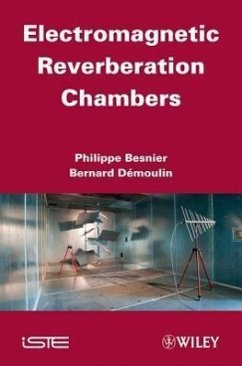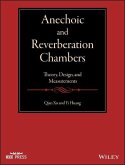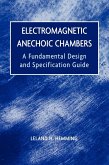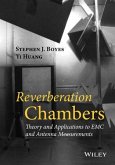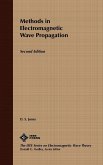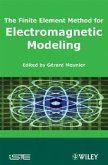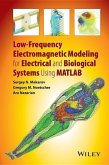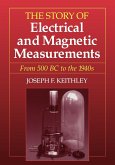- Gebundenes Buch
- Merkliste
- Auf die Merkliste
- Bewerten Bewerten
- Teilen
- Produkt teilen
- Produkterinnerung
- Produkterinnerung
Dedicated to a complete presentation on all aspects of reverberation chambers, this book provides the physical principles behind these test systems in a very progressive manner. The detailed panorama of parameters governing the operation of electromagnetic reverberation chambers details various applications such as radiated immunity, emissivity, and shielding efficiency experiments. In addition, the reader is provided with the elements of electromagnetic theory and statistics required to take full advantage of the basic operational rules of reverberation chambers, including calibration…mehr
Andere Kunden interessierten sich auch für
![Anechoic and Reverberation Chambers Anechoic and Reverberation Chambers]() Qian XuAnechoic and Reverberation Chambers155,99 €
Qian XuAnechoic and Reverberation Chambers155,99 €![Electromagnetic Anechoic Chambers Electromagnetic Anechoic Chambers]() Leland H HemmingElectromagnetic Anechoic Chambers233,99 €
Leland H HemmingElectromagnetic Anechoic Chambers233,99 €![Reverberation Chambers Reverberation Chambers]() Stephen J BoyesReverberation Chambers128,99 €
Stephen J BoyesReverberation Chambers128,99 €![Methods in Electromagnetic Wave Propagation Methods in Electromagnetic Wave Propagation]() D S J JonesMethods in Electromagnetic Wave Propagation237,99 €
D S J JonesMethods in Electromagnetic Wave Propagation237,99 €![The Finite Element Method for Electromagnetic Modeling The Finite Element Method for Electromagnetic Modeling]() The Finite Element Method for Electromagnetic Modeling370,99 €
The Finite Element Method for Electromagnetic Modeling370,99 €![Low-Frequency Electromagnetic Modeling for Electrical and Biological Systems Using MATLAB Low-Frequency Electromagnetic Modeling for Electrical and Biological Systems Using MATLAB]() Sergey N MakarovLow-Frequency Electromagnetic Modeling for Electrical and Biological Systems Using MATLAB170,99 €
Sergey N MakarovLow-Frequency Electromagnetic Modeling for Electrical and Biological Systems Using MATLAB170,99 €![The Story of Electrical and Magnetic Measurements The Story of Electrical and Magnetic Measurements]() Joseph F KeithleyThe Story of Electrical and Magnetic Measurements164,99 €
Joseph F KeithleyThe Story of Electrical and Magnetic Measurements164,99 €-
-
-
Dedicated to a complete presentation on all aspects of reverberation chambers, this book provides the physical principles behind these test systems in a very progressive manner. The detailed panorama of parameters governing the operation of electromagnetic reverberation chambers details various applications such as radiated immunity, emissivity, and shielding efficiency experiments. In addition, the reader is provided with the elements of electromagnetic theory and statistics required to take full advantage of the basic operational rules of reverberation chambers, including calibration procedures. Comparisons with other testing systems (TEM cells, anechoic chambers) are also discussed.
Hinweis: Dieser Artikel kann nur an eine deutsche Lieferadresse ausgeliefert werden.
Hinweis: Dieser Artikel kann nur an eine deutsche Lieferadresse ausgeliefert werden.
Produktdetails
- Produktdetails
- Verlag: Wiley
- Seitenzahl: 432
- Erscheinungstermin: 13. September 2011
- Englisch
- Abmessung: 241mm x 159mm x 30mm
- Gewicht: 753g
- ISBN-13: 9781848212930
- ISBN-10: 1848212933
- Artikelnr.: 33947944
- Herstellerkennzeichnung
- Libri GmbH
- Europaallee 1
- 36244 Bad Hersfeld
- gpsr@libri.de
- Verlag: Wiley
- Seitenzahl: 432
- Erscheinungstermin: 13. September 2011
- Englisch
- Abmessung: 241mm x 159mm x 30mm
- Gewicht: 753g
- ISBN-13: 9781848212930
- ISBN-10: 1848212933
- Artikelnr.: 33947944
- Herstellerkennzeichnung
- Libri GmbH
- Europaallee 1
- 36244 Bad Hersfeld
- gpsr@libri.de
Bernard Démoulin is a professor at the Institute of Electronics, Micro, and Nanotechnologies (IEMN) in Lille, France. Philippe Besnier is a researcher at the National Center for Scientific Research (CNRS) in France.
Preface xiii Foreword xv Paolo CORONA Introduction xix Chapter 1. Position of the Reverberation Chambers in Common Electromagnetic Tests 1 1.1. Introduction 1 1.2. Electromagnetic fields and plane waves 2 1.3. Electromagnetic tests in confined areas 13 1.4. Discussion 26 1.5. Bibliography 28 Chapter 2. Main Physical Features of Electromagnetic Cavities 29 2.1. Introduction 29 2.2. Reduction of the modes in a 1D cavity 30 2.3. Physical features of an empty rectangular cavity 44 2.4. The 3D cavity operating in stirred modes 69 2.5. Discussion 77 2.6. Bibliography 80 Chapter 3. Statistical Behavior of Stirred Waves in an Oversized Cavity 83 3.1. Introduction 83 3.2. Descriptions of the ideal random electromagnetic field 84 3.3. Simulation of the properties of an ideal random field 93 3.4. Contribution of the statistical tests 104 3.5. Balance of power in a reverberation chamber 121 3.6. Discussion 130 3.7. Bibliography 132 Chapter 4. Impact of the Physical and Technological Parameters of a Reverberation Chamber 135 4.1. Introduction 135 4.2. Main parameters for reverberation chamber design 136 4.3. The usual techniques of mode stirring 153 4.4. The characterization of reverberation chambers 164 4.5. Discussion 188 4.6. Bibliography 190 Chapter 5. Radiated Immunity Tests in a Reverberation Chamber 193 5.1. Introduction 193 5.2. The calibration process 194 5.3. Examples of calibration results 206 5.4. Implementing of the immunity test for a piece of equipment 210 5.5. Immunity test in reverberation and anechoic chambers 220 5.6. Rectangular components of the electric field and the total electric field 226 5.7. Discussion 228 5.8. Bibliography 230 Chapter 6. Emissivity Tests in Reverberation Chambers 233 6.1. Introduction 233 6.2. A few notions on electromagnetic radiation and antennas 234 6.3. Measurement of the total radiated power in free space 249 6.4. Measurement of the unintentional emission of a device under test 252 6.5. Measurement examples of the total radiated power 262 6.6. Total radiated power and radiated emissivity 269 6.7. Measurement of the efficiency and of the diversity gain of the antennas 272 6.8. Discussion 275 6.9. Bibliography 276 Chapter 7. Measurement of the Shielding Effectiveness 279 7.1. Introduction 279 7.2. Definitions of the shielding effectiveness 280 7.3. Measurement of the effectiveness of shielded cables and connectors in reverberation chambers 287 7.4. Measurement of the attenuation of the shielded enclosures 302 7.5. Measurement of the shielding effectiveness of the materials 307 7.6. Discussion 316 7.7. Bibliography 318 Chapter 8. Mode Stirring Reverberation Chamber: A Research Tool 321 8.1. Introduction 321 8.2. A non-ideal random electromagnetic field 324 8.3. Studying the correlation of a set of measurements 336 8.4. Quantization of the scattered and coherent fields in a reverberation chamber 349 8.5. Discussion 356 8.6. Bibliography 358 APPENDICES 361 Appendix 1. Notion of Probability 363 A1.1. The random variable concept 363 A1.2. Probability concept from intuition 363 A1.3. Probability density function (pdf) 364 A1.4. Computation of moments 365 A1.5. Centered and normalized variables 366 A1.6. Computation of the variance and standard deviation 367 A1.7. Probability distributions 367 A1.8. The cumulative distribution function (cdf) 369 A1.9. The ergodism notion 369 A1.10. Features of the random stationary variables 372 A1.11. The characteristic function 373 A1.12. Summary of the main probability distributions 375 A1.13. Tables of numerical values of the normal distribution integrals 378 A1.14. Bibliography 379 Appendix 2. Formulas of the Quality Factor of a Rectangular Cavity 381 A2.1. Quality factor of the TMm n p mode 381 A2.2. Calculation of the average Q quality factor 382 A2.3. Bibliography 384 Appendix 3. Total Field and Total Power Variables 385 A3.1. Total field variables 385 A3.2.
2 variable attached to the total field 386 A3.3. Total field probability density function 386 A3.4. Calculation of the mean of the total field 387 A3.5. The pdf of the total power 388 A3.6. Calculation of the mean total powers 389 Appendix 4. Calculation of the Variances of
,
,
391 A4.1. Variance of the
and
variables 391 A4.2. Variance of the
variable 392 Appendix 5. Electric Dipole Formulas 395 A5.1. Complete formulas of the electric dipole 395 A5.2. Near-field formulas of the electric dipole 397 A5.3. Far-field formulas of the electric dipole 397 A5.4. Bibliography 398 Index 399
2 variable attached to the total field 386 A3.3. Total field probability density function 386 A3.4. Calculation of the mean of the total field 387 A3.5. The pdf of the total power 388 A3.6. Calculation of the mean total powers 389 Appendix 4. Calculation of the Variances of
,
,
391 A4.1. Variance of the
and
variables 391 A4.2. Variance of the
variable 392 Appendix 5. Electric Dipole Formulas 395 A5.1. Complete formulas of the electric dipole 395 A5.2. Near-field formulas of the electric dipole 397 A5.3. Far-field formulas of the electric dipole 397 A5.4. Bibliography 398 Index 399
Preface xiii Foreword xv Paolo CORONA Introduction xix Chapter 1. Position of the Reverberation Chambers in Common Electromagnetic Tests 1 1.1. Introduction 1 1.2. Electromagnetic fields and plane waves 2 1.3. Electromagnetic tests in confined areas 13 1.4. Discussion 26 1.5. Bibliography 28 Chapter 2. Main Physical Features of Electromagnetic Cavities 29 2.1. Introduction 29 2.2. Reduction of the modes in a 1D cavity 30 2.3. Physical features of an empty rectangular cavity 44 2.4. The 3D cavity operating in stirred modes 69 2.5. Discussion 77 2.6. Bibliography 80 Chapter 3. Statistical Behavior of Stirred Waves in an Oversized Cavity 83 3.1. Introduction 83 3.2. Descriptions of the ideal random electromagnetic field 84 3.3. Simulation of the properties of an ideal random field 93 3.4. Contribution of the statistical tests 104 3.5. Balance of power in a reverberation chamber 121 3.6. Discussion 130 3.7. Bibliography 132 Chapter 4. Impact of the Physical and Technological Parameters of a Reverberation Chamber 135 4.1. Introduction 135 4.2. Main parameters for reverberation chamber design 136 4.3. The usual techniques of mode stirring 153 4.4. The characterization of reverberation chambers 164 4.5. Discussion 188 4.6. Bibliography 190 Chapter 5. Radiated Immunity Tests in a Reverberation Chamber 193 5.1. Introduction 193 5.2. The calibration process 194 5.3. Examples of calibration results 206 5.4. Implementing of the immunity test for a piece of equipment 210 5.5. Immunity test in reverberation and anechoic chambers 220 5.6. Rectangular components of the electric field and the total electric field 226 5.7. Discussion 228 5.8. Bibliography 230 Chapter 6. Emissivity Tests in Reverberation Chambers 233 6.1. Introduction 233 6.2. A few notions on electromagnetic radiation and antennas 234 6.3. Measurement of the total radiated power in free space 249 6.4. Measurement of the unintentional emission of a device under test 252 6.5. Measurement examples of the total radiated power 262 6.6. Total radiated power and radiated emissivity 269 6.7. Measurement of the efficiency and of the diversity gain of the antennas 272 6.8. Discussion 275 6.9. Bibliography 276 Chapter 7. Measurement of the Shielding Effectiveness 279 7.1. Introduction 279 7.2. Definitions of the shielding effectiveness 280 7.3. Measurement of the effectiveness of shielded cables and connectors in reverberation chambers 287 7.4. Measurement of the attenuation of the shielded enclosures 302 7.5. Measurement of the shielding effectiveness of the materials 307 7.6. Discussion 316 7.7. Bibliography 318 Chapter 8. Mode Stirring Reverberation Chamber: A Research Tool 321 8.1. Introduction 321 8.2. A non-ideal random electromagnetic field 324 8.3. Studying the correlation of a set of measurements 336 8.4. Quantization of the scattered and coherent fields in a reverberation chamber 349 8.5. Discussion 356 8.6. Bibliography 358 APPENDICES 361 Appendix 1. Notion of Probability 363 A1.1. The random variable concept 363 A1.2. Probability concept from intuition 363 A1.3. Probability density function (pdf) 364 A1.4. Computation of moments 365 A1.5. Centered and normalized variables 366 A1.6. Computation of the variance and standard deviation 367 A1.7. Probability distributions 367 A1.8. The cumulative distribution function (cdf) 369 A1.9. The ergodism notion 369 A1.10. Features of the random stationary variables 372 A1.11. The characteristic function 373 A1.12. Summary of the main probability distributions 375 A1.13. Tables of numerical values of the normal distribution integrals 378 A1.14. Bibliography 379 Appendix 2. Formulas of the Quality Factor of a Rectangular Cavity 381 A2.1. Quality factor of the TMm n p mode 381 A2.2. Calculation of the average Q quality factor 382 A2.3. Bibliography 384 Appendix 3. Total Field and Total Power Variables 385 A3.1. Total field variables 385 A3.2.
2 variable attached to the total field 386 A3.3. Total field probability density function 386 A3.4. Calculation of the mean of the total field 387 A3.5. The pdf of the total power 388 A3.6. Calculation of the mean total powers 389 Appendix 4. Calculation of the Variances of
,
,
391 A4.1. Variance of the
and
variables 391 A4.2. Variance of the
variable 392 Appendix 5. Electric Dipole Formulas 395 A5.1. Complete formulas of the electric dipole 395 A5.2. Near-field formulas of the electric dipole 397 A5.3. Far-field formulas of the electric dipole 397 A5.4. Bibliography 398 Index 399
2 variable attached to the total field 386 A3.3. Total field probability density function 386 A3.4. Calculation of the mean of the total field 387 A3.5. The pdf of the total power 388 A3.6. Calculation of the mean total powers 389 Appendix 4. Calculation of the Variances of
,
,
391 A4.1. Variance of the
and
variables 391 A4.2. Variance of the
variable 392 Appendix 5. Electric Dipole Formulas 395 A5.1. Complete formulas of the electric dipole 395 A5.2. Near-field formulas of the electric dipole 397 A5.3. Far-field formulas of the electric dipole 397 A5.4. Bibliography 398 Index 399

